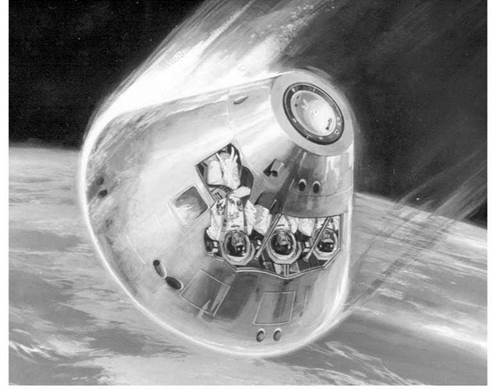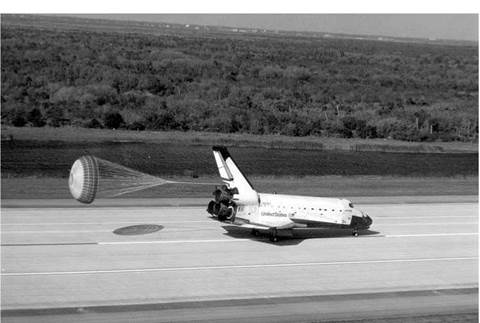Landing methods
All US manned space mission landings up to the Space Shuttle programme were “splashdowns” in either the Atlantic or Pacific Ocean. The crew vehicles descended under parachutes after re-entry into the atmosphere, and a recovery crew would
|
Diagram of an Apollo re-entry configuration |
attach a flotation device to the capsule once it had hit the ocean. This was not always the case with some Mercury and Gemini missions, which landed outside the planned recovery area. This method was easier than developing terrain landing capabilities, although Gemini and Apollo spacecraft development teams did investigate this option. Splashdowns still carried the risk of drowning the crew or the possibility of a parachute failure, and there was also the added expense of drafting a flotilla of military ships for each mission recovery.
Soviet or Russian missions have always been targeted for landing in home territory, normally Kazakhstan. Vostok pilots ejected from their capsules and landed by separate parachute as developing a soft landing system to protect the occupant was deemed too complicated and time-consuming in the race to beat the Americans to orbit. Voskhod crews landed in their craft under parachutes, aided by retro-rockets in the parachute support system. A more effective system was incorporated in the base of the Soyuz, with four solid propellant rocket engines fired 1.5 metres off the ground to effect what is known as a “dust-down” or a “soft-landing”. While this is usually reliable, it has occasionally proven otherwise. This method is also used by the Chinese Shenzhou, which is based on the Russian Soyuz design.
|
The Shuttle Landing Facility (SLF) at the Kennedy Space Center |
The Space Shuttle orbiter lands on a runway and has used three sites – mainly the concrete Shuttle Landing Facility at the Kennedy Space Center in Florida and the concrete or dry lake bed runways at Edwards AFB in California. One landing was made at the Northrop Strip (gypsum) at White Sands in New Mexico. There is also a network of contingency landing sites around the globe, all with long runways for use as emergency return options for the Shuttle.












